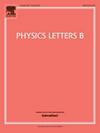Jet momentum reconstruction in the QGP background with machine learning
IF 4.5
2区 物理与天体物理
Q1 ASTRONOMY & ASTROPHYSICS
引用次数: 0
Abstract
We apply a Dense Neural Network (DNN) approach to reconstruct jet momentum within a quark-gluon plasma (QGP) background, using simulated data from PYTHIA and Linear Boltzmann Transport (LBT) Models for comparative analysis. We find that medium response particles from the LBT simulation, scattered out of the QGP background but belonging to medium-modified jets, lead to oversubtraction of the background if the DNN model is trained on vacuum jets from PYTHIA simulation. By training the DNN model on quenched jets generated using LBT or the combination of jet samples from PYTHIA and LBT, we significantly reduce this prediction bias and achieve more accurate background subtraction compared to conventional Area-based and Constituent Subtraction methods widely adopted in experimental measurements. We further study the performance of these machine learning models on evaluating the nuclear modification factor of jets, and find that while the unfolding procedure is necessary for correcting residuals in reconstructed jet momenta, models trained on samples incorporating quenched jets still achieve superior accuracy than those trained on vacuum jets even after unfolding.
基于机器学习的QGP背景下射流动量重建
我们应用密集神经网络(DNN)方法重建夸克-胶子等离子体(QGP)背景下的射流动量,使用PYTHIA和线性玻尔兹曼输运(LBT)模型的模拟数据进行比较分析。我们发现来自LBT模拟的中等响应粒子分散在QGP背景之外,但属于中等修正的射流,如果DNN模型在PYTHIA模拟的真空射流上训练,会导致背景的过减。通过对使用LBT或PYTHIA和LBT的射流样本组合生成的淬火射流进行DNN模型训练,我们显著降低了这种预测偏差,并且与实验测量中广泛采用的传统基于区域和成分减法方法相比,实现了更准确的背景减法。我们进一步研究了这些机器学习模型在评估射流核修饰因子方面的性能,并发现尽管对重建射流动量的残差进行校正是必要的,但在包含淬火射流的样本上训练的模型即使在展开后仍然比在真空射流上训练的模型具有更高的精度。
本文章由计算机程序翻译,如有差异,请以英文原文为准。
求助全文
约1分钟内获得全文
求助全文
来源期刊

Physics Letters B
物理-物理:综合
CiteScore
9.10
自引率
6.80%
发文量
647
审稿时长
3 months
期刊介绍:
Physics Letters B ensures the rapid publication of important new results in particle physics, nuclear physics and cosmology. Specialized editors are responsible for contributions in experimental nuclear physics, theoretical nuclear physics, experimental high-energy physics, theoretical high-energy physics, and astrophysics.
 求助内容:
求助内容: 应助结果提醒方式:
应助结果提醒方式:


